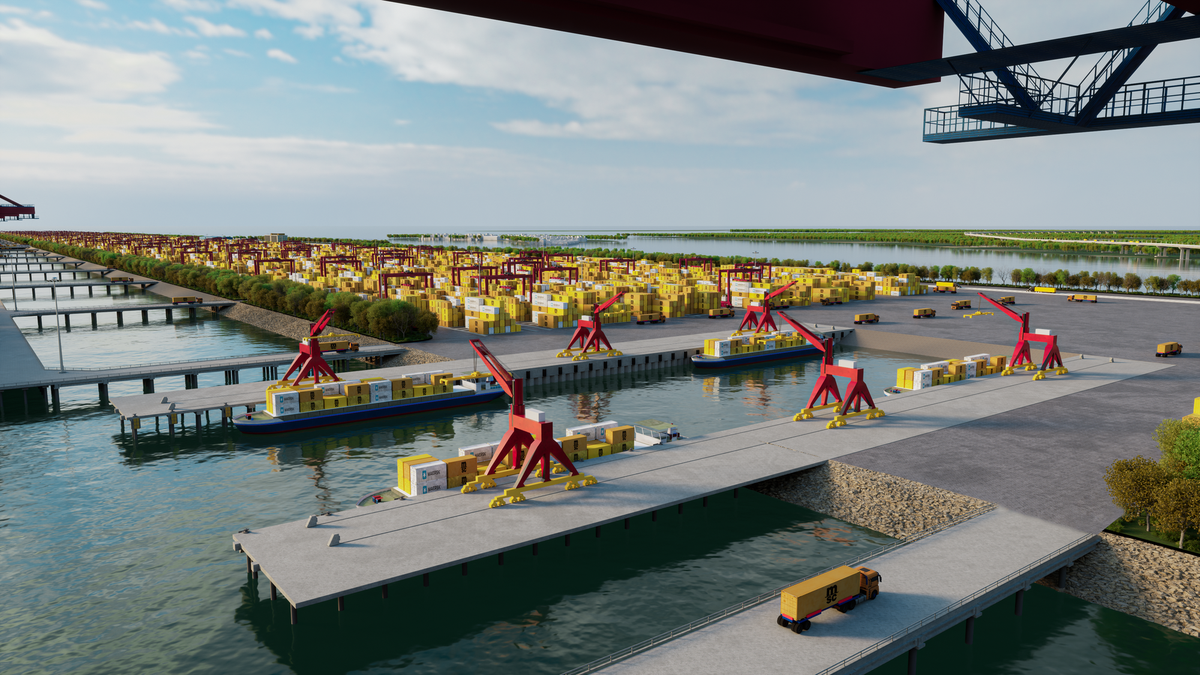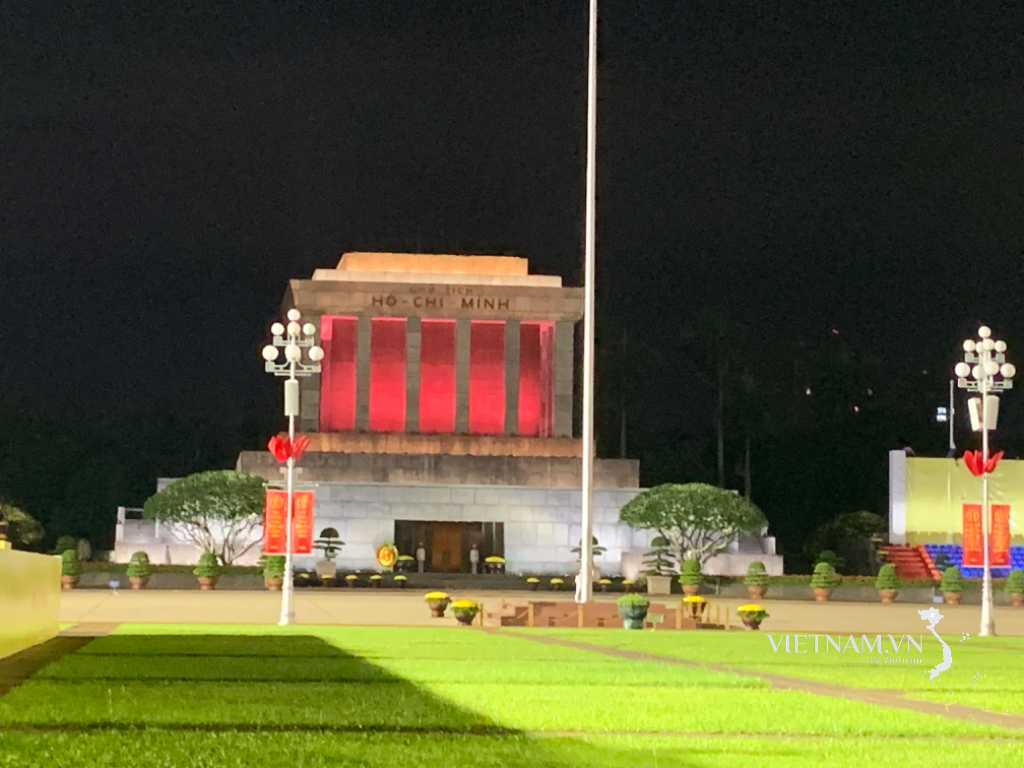In 2024, Ho Chi Minh City's GRDP (gross regional product) growth was 7.17%. In 2025, the Government issued a resolution assigning Ho Chi Minh City the target of achieving 8.5% growth.

Perspective view of Can Gio International Transshipment Port - Photo: Portcoast
Ho Chi Minh City aims for a 10% growth rate to create momentum for double-digit growth in subsequent years. Achieving these figures requires significant effort, perseverance, groundbreaking solutions, and especially a proactive approach.
There are many different viewpoints on how to proceed, but the "8 + 2" approach should be supported – meaning building a solid foundation to achieve 8% while simultaneously making a breakthrough in the remaining 2% to reach the 10% target.
Why is it necessary to be thorough and innovative? Before COVID-19, from 2017 to 2019, the city had a growth rate of 8%.
However, this growth momentum has not been sustained since the arrival of COVID-19. Therefore, solutions must be strengthened to achieve an 8% growth rate. In the years when the city achieved 8% growth, what growth drivers did it rely on?
These include social investment, consumption, and exports. For Ho Chi Minh City, social investment is a decisive factor in growth. Previously, this accounted for about 33% of the city's GRDP, but recently it has only reached 22.4%.
Therefore, to achieve high growth, Ho Chi Minh City must mobilize resources to bring total social investment back to 33% of GRDP.
Assuming the target growth rate is 10%, the city's GRDP should reach approximately 2 trillion VND. Therefore, 33% of 2 trillion VND is 660,000 billion VND. Of this, public investment and the state sector account for 120,000 billion VND.
The remaining over 500 trillion VND must be mobilized from the private sector and the foreign-invested sector. In recent years, mobilization from these two sectors has somewhat decreased, and now this capital flow needs to be revived. What is the basis for this? The three main breakthroughs remain: institutions, infrastructure, and human resources.
Institutionally, Ho Chi Minh City must demonstrate strong determination to reform its administrative procedures and improve the investment and business environment to meet the expectations of its citizens and businesses.
Indicators in which Ho Chi Minh City has long lagged behind the national average, such as the PCI (Provincial Competitiveness Index) and the PAR Index (Public Administration Reform Index), must now be reclaimed to take the top position.
The second factor is infrastructure. Although Ho Chi Minh City has invested heavily in improvements, it still hasn't met the requirements.
Therefore, the city must continue to invest more in infrastructure, especially transportation infrastructure. This includes urban railway lines and ring roads, along with expressways connecting to other localities in the region.
This will lead to the development of industrial park infrastructure, attract investment in clean land, and simultaneously create new industrial parks while restructuring existing ones towards science , technology, innovation, and digital transformation.
Simultaneously investing in cultural and tourism infrastructure is both a strength and an intrinsic driving force to help the city's economy grow sustainably.
The third factor is human resources and organizational structure. The city is streamlining its apparatus towards efficiency, effectiveness, and effectiveness.
We must select the right workforce with the necessary skills and innovative thinking to serve the people and businesses. Focusing on these three breakthroughs is essential to maintaining traditional growth momentum and achieving the 8% target.
So where should the remaining 2% begin? We must immediately implement projects such as the international financial center, the Can Gio international transshipment port, the Can Gio free trade zone, the Can Gio reclaimed land urban area, and action programs to implement Resolution 57 of the Central Committee on science and technology, innovation, and digital transformation.
The city has also established a Digital Transformation Center, a Center for the Fourth Industrial Revolution, a Center for Creative Startups, as well as research institutes at universities, testing centers, sandboxes, etc., to support small and medium-sized enterprises in accelerating their development.
In addition, the city must also focus on high-quality service centers such as healthcare, science and technology services, and logistics services. These developments will also contribute to increasing GRDP, especially in the coming years.
Source: https://tuoitre.vn/don-luc-cho-nhip-di-8-2-20250211085846796.htm


![[Image] Leaked images ahead of the 2025 Community Action Awards gala.](/_next/image?url=https%3A%2F%2Fvphoto.vietnam.vn%2Fthumb%2F1200x675%2Fvietnam%2Fresource%2FIMAGE%2F2025%2F12%2F16%2F1765882828720_ndo_br_thiet-ke-chua-co-ten-45-png.webp&w=3840&q=75)

![[Live] 2025 Community Action Awards Gala](/_next/image?url=https%3A%2F%2Fvphoto.vietnam.vn%2Fthumb%2F1200x675%2Fvietnam%2Fresource%2FIMAGE%2F2025%2F12%2F16%2F1765899631650_ndo_tr_z7334013144784-9f9fe10a6d63584c85aff40f2957c250-jpg.webp&w=3840&q=75)
![[Photo] Prime Minister Pham Minh Chinh receives the Governor of Tochigi Province (Japan)](/_next/image?url=https%3A%2F%2Fvphoto.vietnam.vn%2Fthumb%2F1200x675%2Fvietnam%2Fresource%2FIMAGE%2F2025%2F12%2F16%2F1765892133176_dsc-8082-6425-jpg.webp&w=3840&q=75)
![[Photo] Prime Minister Pham Minh Chinh receives Lao Minister of Education and Sports Thongsalith Mangnormek](/_next/image?url=https%3A%2F%2Fvphoto.vietnam.vn%2Fthumb%2F1200x675%2Fvietnam%2Fresource%2FIMAGE%2F2025%2F12%2F16%2F1765876834721_dsc-7519-jpg.webp&w=3840&q=75)









































































![[Live] Closing Ceremony and Award Presentation for the "Impressive Vietnam Tourism" Video/Clip Creation Contest 2025](https://vphoto.vietnam.vn/thumb/402x226/vietnam/resource/IMAGE/2025/12/17/1765974650260_z7273498850699-00d2fd6b0972cb39494cfa2559bf85ac-1765959338756946072104-627-0-1338-1138-crop-1765959347256801551121.jpeg)




























Comment (0)